Your essential and fragrance oils fade during cold process soaping due to several chemical factors. The high pH environment created by lye can break down scent compounds, while elevated temperatures during saponification cause volatile oils to evaporate. Even after the initial process, lighter oils continue losing potency throughout the curing phase. You can combat this using natural anchoring methods, proper temperature control, and stabilizing additives – techniques that'll help you master lasting fragrances in your soaps.
Understanding the Chemistry of Oil Fading

When essential and fragrance oils meet the intense chemical environment of cold process soapmaking, they face multiple challenges that can lead to scent fading.
You'll notice that lighter oils, especially citrus and floral fragrances, are particularly vulnerable to the dramatic pH changes that occur during saponification, which can alter their chemical structure.
During the gel phase, when temperatures climb between 160°F to 200°F, oils with lower flashpoints will evaporate more readily.
The molecular weight of your essential oils plays a significant role too – lighter, more aromatic compounds tend to dissipate faster when exposed to heat and moisture.
To combat this, you can anchor your fragrances by combining them with deeper, earthier essential oils or incorporating clays that help stabilize the scent throughout the curing process.
Essential Oil Properties and Volatility Rates
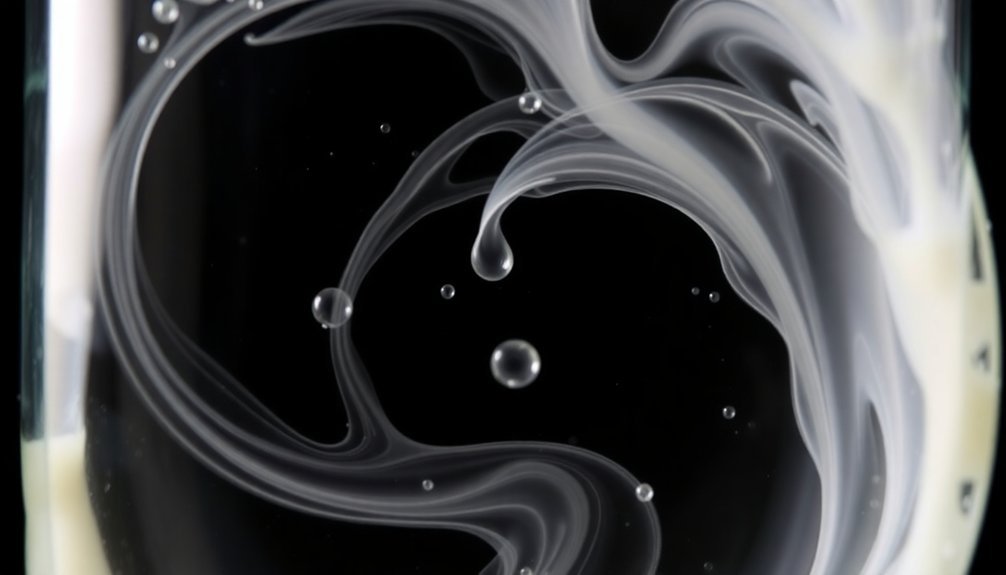
Understanding how essential oils behave in cold process soap starts with their volatility rates. You'll notice that different essential oils evaporate at varying speeds, affecting their scent retention in your final product. Lighter fragrances, especially citrus oils, tend to fade quickly, while base notes like patchouli show better staying power.
Key factors affecting essential oil performance include:
- Flashpoint temperatures relative to soap's gel phase
- Chemical interactions with lye that can alter fragrance compounds
- Natural volatility rates of different oil compounds
To maximize scent retention in your soaps, you'll want to create essential oil blends that combine different volatility rates. When you incorporate heavier base notes with middle notes, you'll achieve better fragrance longevity throughout the curing process.
Understanding these properties helps you formulate more effective, longer-lasting soap scents.
Temperature Impact on Scent Retention
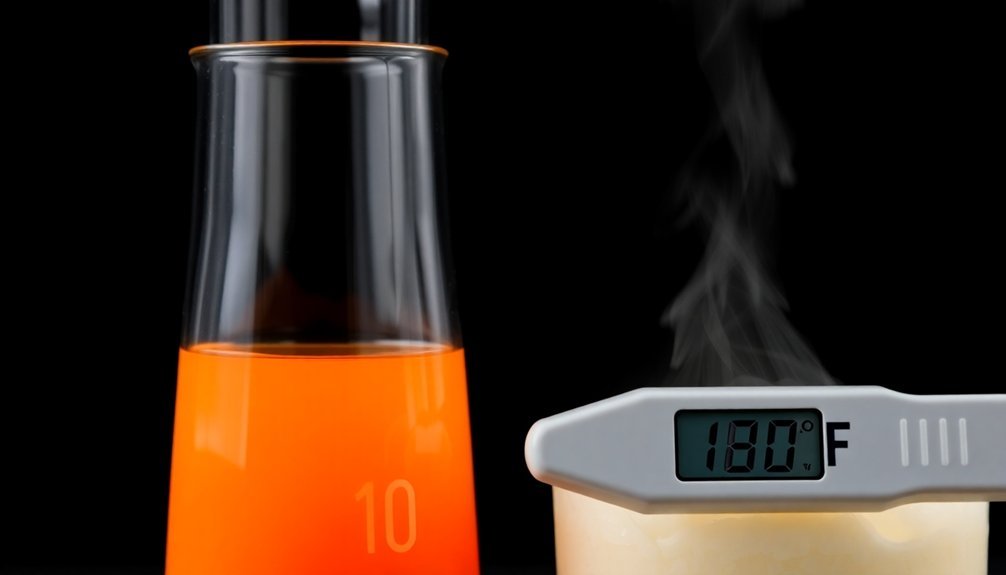
You'll need to carefully monitor soap temperatures during processing, as fragrance oils with low flashpoints can quickly fade when exposed to the intense heat of gel phase, which often reaches 160-200°F.
To maximize scent retention, you're better off choosing fragrance oils with medium to high flashpoints that won't evaporate during the saponification process.
You can further protect your fragrances by adding them at trace temperature and storing finished soaps away from heat and direct sunlight.
Flashpoint Heat Fading Effects
The delicate relationship between temperature and scent retention poses a significant challenge in cold process soap making. When your soap reaches high temperatures during saponification (160-200°F), essential oils with low flashpoints can evaporate, leading to significant scent fading.
Understanding this interaction is vital for preserving fragrance in your final product.
To maximize scent retention in cold process soap making, consider these key factors:
- Choose essential oils with medium to high flashpoints that can withstand the heat of saponification
- Add fragrance oils at trace rather than before introducing lye to minimize heat exposure
- Monitor boiling points (typically above 300°F) alongside flashpoints to better predict scent stability
You'll achieve better results by selecting appropriate oils and timing their addition strategically, ensuring your soap maintains its desired fragrance throughout the curing process.
Optimal Temperature Control Methods
When crafting cold process soap, maintaining precise temperature control stands as a critical factor in preserving your chosen fragrances.
You'll want to monitor your soapmaking process carefully, as temperatures reaching 160°F to 200°F during gel phase can greatly impact scent retention.
To protect your fragrance oils, you should add them at trace rather than mixing them with lye. This timing helps prevent unnecessary exposure to high temperatures that could compromise their integrity.
Pay attention to the flashpoint of your chosen oils – those with higher flashpoints will better withstand the heat of cold process soaping.
Throughout the curing phase, you'll need to maintain steady temperatures to minimize scent fading.
Natural Anchoring Methods for Lasting Fragrance
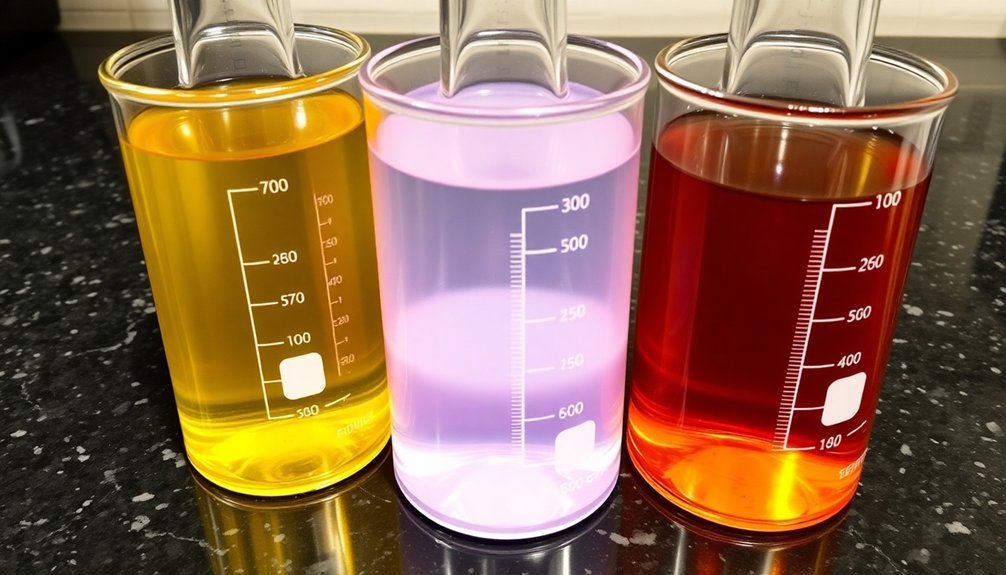
Successfully anchoring fragrances in cold process soap requires understanding natural methods that enhance scent longevity.
Creating long-lasting scents in handmade soap starts with mastering natural anchoring techniques that preserve fragrance through the curing process.
You'll find that pairing lighter essential oils with deeper, earthy scents like amber or patchouli greatly improves fragrance retention.
Kaolin clay works as an excellent natural anchoring method, absorbing essential oils while adding beneficial slip to your soap.
For best results in your cold process soap, consider these proven techniques:
- Mix cornstarch with essential oils (one tablespoon per pound) to enhance fragrance longevity and lather
- Use concentrated versions of citrus oils, like Orange 10X, combined with base notes
- Store your soaps in a cool, dry place away from direct sunlight during curing
These natural anchoring methods will help guarantee your essential oils maintain their intended fragrance throughout the soap's life.
Clay Additives and Their Stabilizing Effects
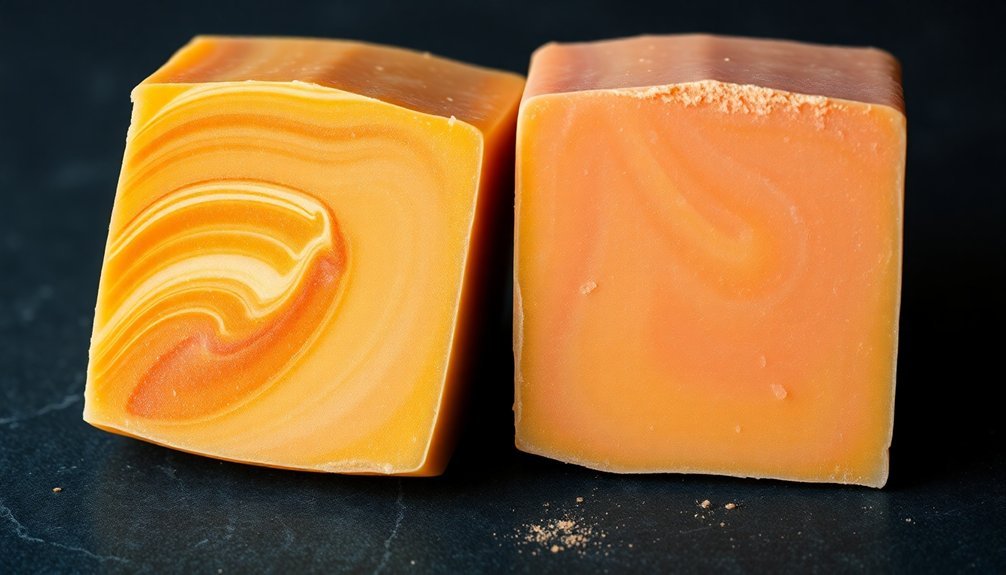
You'll find kaolin clay to be a versatile stabilizing agent in cold process soap, helping retain essential oil scents while adding subtle color and smooth slip qualities to your final product.
To maximize clay's benefits, mix 1 teaspoon of kaolin with 1 tablespoon of distilled water before incorporating it into your soap batter, ensuring even distribution throughout the mixture.
For best results, you can combine clay with other natural anchoring agents like diatomaceous earth, starting with 1/2 teaspoon per pound of soap base.
Types of Clay Benefits
Clay additives play an essential role in cold process soap making, particularly in enhancing fragrance retention and overall soap stability.
You'll find that kaolin clay effectively absorbs essential oils and helps maintain scent throughout the curing process. When you're looking to improve your soap's fragrance longevity, consider these key benefits:
- Kaolin clay works alongside other dry additives like cornstarch to maximize scent retention and enhance soap quality.
- Mix 1 teaspoon of kaolin clay with 1 tablespoon of distilled water for ideal dispersion in your soap mixture.
- The stability of scents improves with clay additions, while also providing subtle coloring and improved texture.
For best results, you'll want to incorporate these clay additives properly into your cold process soap.
While research continues, current evidence suggests that kaolin clay considerably contributes to maintaining lasting fragrances in your finished products.
Clay Mixing Techniques
The proper mixing of clay additives greatly impacts your soap's final quality and fragrance retention.
When working with kaolin clay in your cold process soap, you'll want to mix 1 teaspoon of clay with 1 tablespoon of distilled water before adding it to your soap formulation. This pre-mixing technique guarantees even distribution and maximizes scent retention of your fragrance oils.
If you're incorporating dry additives like diatomaceous earth, mix it with alcohol first to prevent clumping.
These additives not only enhance quality but also provide excellent slip to your final product.
When you're working with clay in particular, you'll notice it contributes subtle color and texture while helping stabilize fragrances.
Optimal Clay Ratios
When crafting cold process soap with clay additives, understanding precise ratios becomes essential for achieving ideal results. For optimal fragrance retention, start with kaolin clay at 1 teaspoon per pound of soap. This ratio helps stabilize scents while improving your soap's texture and slip qualities.
- Mix kaolin clay directly with essential oils before adding to your soap recipe to maximize scent absorption.
- Consider diatomaceous earth as an alternative, using 1/2 teaspoon per pound of soap, pre-mixed with alcohol.
- Test different clay types in your cold process soap, adjusting ratios between 1/2 to 1 teaspoon per pound.
Storage Solutions for Maximum Scent Preservation
Properly storing handmade soap plays an essential role in preserving its fragrance over time. To prevent scent fading, you'll want to store your soaps in a cool, dry place away from direct sunlight.
Using airtight containers is vital, as they protect your soap from air exposure that can lead to fragrance degradation.
When organizing your storage solutions, group similar scented soaps together to avoid scent fatigue. You can enhance fragrance integrity during the curing process by placing scented cotton balls near your soap, but keep them away from plastic surfaces.
Pay close attention to environmental factors, as humidity and temperature fluctuations can greatly impact your soap's scent longevity.
Measuring and Timing Essential Oil Addition
Beyond storing your soaps effectively, mastering the precise timing and measurement of essential oil additions will determine your soap's lasting fragrance.
For ideal retention, you'll want to add your essential oil at trace, preventing unwanted chemical reactions with lye that can diminish scent potency. The standard measurement is 1 ounce of essential oil per pound of soaping oils, though you may need to adjust based on specific oil properties.
- Add your essential oils or fragrance oils at trace – never before introducing lye
- Measure precisely using the 1-ounce-per-pound rule as your baseline
- Test different addition times during trace to find your perfect timing
Through careful measurement and strategic timing of your essential oil addition, you'll maximize fragrance preservation and create consistently scented soaps that your customers will love.
Blending Techniques for Stronger Scent Profiles
When you're blending essential oils for cold process soap, start by combining lighter top notes with heavier base scents to create lasting fragrance profiles.
You'll want to anchor citrus or floral scents with earthier oils like patchouli or sandalwood to prevent premature fading.
Your blend should incorporate well-rounded middle notes that bridge the gap between top and base notes, creating a harmonious and enduring scent experience.
Layering Essential Oil Notes
Three key layers form the foundation of successful essential oil blending in cold process soap: top, middle, and base notes.
You'll find that base notes offer the best scent retention, while citrus essential oils tend to fade quickly. To combat this, try pairing lighter fragrances with earthier scents like patchouli essential oil.
Here's what you need to know about effective layering:
- Use concentrated versions (like 10X orange) to enhance staying power
- Combine lighter scents with deep, earthy base notes to anchor the fragrance
- Experiment with different blending ratios to find your perfect balance
The key to success lies in creating well-rounded combinations that include middle notes like lavender or rosemary.
These help bridge the gap between your top and base notes, resulting in a more complex and lasting fragrance profile.
Anchoring With Base Scents
Since light essential oils often fade quickly in cold process soap, mastering the art of anchoring with base notes becomes crucial for lasting fragrance.
You'll find that pairing lighter essential oil scents, particularly citrus varieties, with deeper base notes like Amber or Patchouli can effectively anchor the scent and improve fragrance retention.
To create a complex scent that lasts, you'll want to experiment with different combinations of oils that fade in soap alongside stable anchoring elements.
Try using concentrated versions like 10X Orange to maintain bright notes while achieving better staying power.
You can develop a balanced scent profile by strategically blending fading oils with heavier base notes.
This approach not only preserves the fragrance but also allows you to discover unique combinations that maintain their strength throughout your soap's lifespan.
Environmental Factors Affecting Oil Stability
Although essential oils contribute delightful fragrances to cold process soaps, their stability relies heavily on environmental conditions.
You'll need to carefully manage these environmental factors to prevent premature scent fading in your soaps. Temperature fluctuations and direct sunlight exposure can cause essential oils to evaporate and degrade, while humidity affects both essential and fragrance oils' stability.
To protect your soap's scent profile, consider these key storage factors:
- Store soaps in a cool, dark place away from UV rays
- Keep your soaps in airtight containers to minimize oxidation
- Control humidity levels in your storage area
Understanding how environmental factors impact oil stability helps you maintain fragrance intensity throughout the curing process.
The chemical reactions during saponification already challenge scent retention, so controlling external conditions becomes vital for preserving your soap's intended aroma.
Water Content and Fragrance Concentration
When crafting cold process soap, the water content in your recipe directly impacts how well fragrances perform and persist. If you're using too much water, you'll notice your essential oils becoming diluted, resulting in weaker scents that fade quickly over time.
To maximize fragrance retention, you'll want to maintain a careful balance between water and oils during saponification. You can protect your fragrance concentration by adding essential oils at trace, rather than mixing them in before the lye. This helps avoid unwanted chemical reactions during the intense heat of cold process soaping.
Remember that temperatures can reach up to 200°F during the gel phase, potentially affecting your chosen scents. After curing, proper storage in a cool, dry place away from sunlight will help maintain the strength of your fragrances longer.
Curing Methods to Minimize Scent Loss
Proper curing methods play an essential role in preserving your soap's fragrance throughout the aging process. To maintain fragrance integrity, you'll need to cure soap in a cool, dry place away from direct sunlight.
Managing your curing environment carefully helps prevent scent fatigue and guarantees your fragrances remain distinct.
Here's what you can do to minimize scent loss:
- Store your cured soaps in airtight containers to protect against air exposure
- Group similar scented soaps together during storage to preserve their unique aromas
- Place cotton balls soaked in fragrance oil near (but not touching) your soaps during curing
Remember to monitor humidity levels and temperature stability in your storage area.
These environmental factors greatly impact how well your soap retains its scent throughout the curing process.
Selecting Oils With Superior Retention Properties
Beyond careful curing methods, your choice of fragrance oils directly impacts how well your soap maintains its scent. When selecting oils, prioritize those with high flash points, as they're less likely to evaporate during saponification.
You'll find better staying power with base notes like patchouli, amber, and sandalwood compared to lighter fragrances. For citrus scents, opt for concentrated versions (10X) and anchor them with earthier notes to prevent fading.
You can enhance scent retention by adding kaolin clay or cornstarch to your soap mixture, as these ingredients help absorb excess moisture while holding onto essential oils.
Don't forget to consult the Bramble Berry Fragrance Calculator for precise measurements of your chosen fragrance oils – this guarantees you're using the ideal amount for maximum scent longevity.
Testing and Documentation of Scent Performance
To develop successful soap formulations, systematic testing and detailed documentation of scent performance provide invaluable insights into fragrance behavior.
You'll need to test small batches of cold process soap while tracking how different fragrance oils perform under various curing conditions.
When documenting your results, focus on:
- Initial scent strength and changes throughout the curing process
- Environmental factors like temperature and humidity that affect scent retention
- Specific oil concentrations and their interaction with other ingredients
Keep a standardized testing method to guarantee reliable data collection.
By maintaining detailed records of each batch, you'll identify patterns in scent retention and understand which fragrance oils perform better in your soap formulations.
This systematic approach helps you make informed adjustments to future recipes, ultimately creating products with superior scent performance.
Frequently Asked Questions
Why Does Oil Disappear in Soap?
Your fragrance oils fade because they're reacting to soap's high pH level and saponification process. Heat and chemical changes break down volatile compounds, while factors like evaporation and exposure to light reduce scent strength.
How to Prevent Scent Fading in Cold Process Soap?
You'll prevent scent fading by using high-flashpoint oils, adding kaolin clay, anchoring light scents with earthy ones, storing soap properly, and mixing fragrances at trace instead of before adding lye.
What Is the 30/50/20 Rule for Essential Oils?
You'll want to blend your essential oils using 30% top notes (light scents), 50% middle notes (main fragrances), and 20% base notes (deep scents) to create well-balanced, long-lasting aromas in your soap formulations.
How to Make Essential Oils Last Longer in Soap?
You'll get longer-lasting scents by adding 0.8 oz of oils per pound at trace, using kaolin clay as an anchor, combining light and deep fragrances, and storing soaps in cool, dark places during curing.
In Summary
You'll find that understanding oil fading in cold process soap involves multiple factors – from chemistry to technique. By selecting oils with strong staying power, using natural anchors like clay, and adjusting your water ratios, you can greatly improve scent retention. Remember to document your results and test different methods. With proper temperature control and curing practices, you'll create soaps that maintain their fragrance far longer.

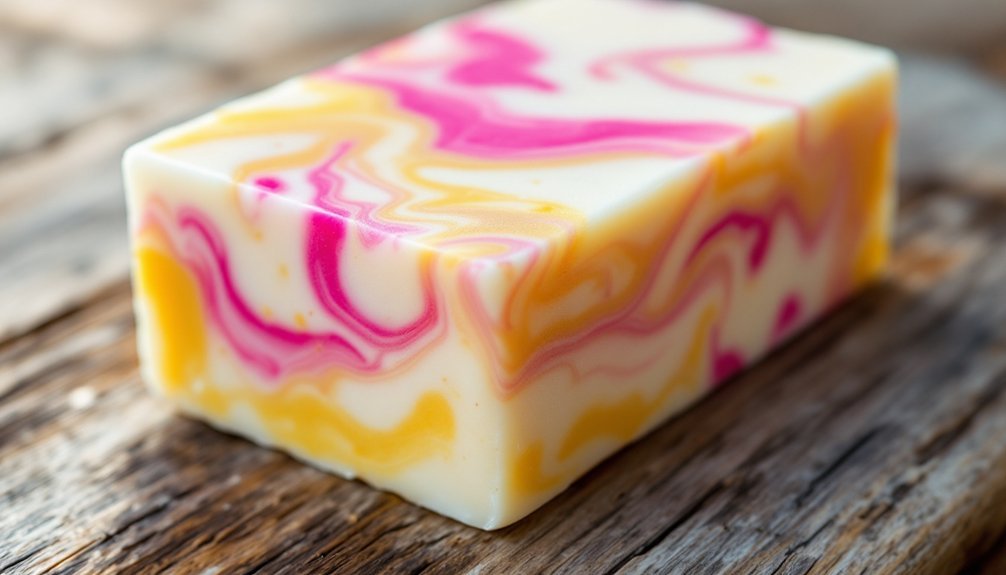



Leave a Reply